The Public Life of Sherlock Holmes: The Moriarty Chronicles
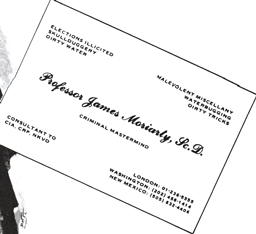 Perhaps my favorite Sherlock Holmes pastiche is 1974’s The Return of Moriarty by John Gardner. In it, Professor Moriarty (who did not perish at the Reichenbach Falls) is a Victorian Era godfather, with a criminal organization the envy of the American mob in the Roaring Twenties. A sequel followed it the next year, The Revenge of Moriarty. The trilogy was completed with Moriarty, just a few weeks before Gardner passed away in 2008.
Perhaps my favorite Sherlock Holmes pastiche is 1974’s The Return of Moriarty by John Gardner. In it, Professor Moriarty (who did not perish at the Reichenbach Falls) is a Victorian Era godfather, with a criminal organization the envy of the American mob in the Roaring Twenties. A sequel followed it the next year, The Revenge of Moriarty. The trilogy was completed with Moriarty, just a few weeks before Gardner passed away in 2008.
Having completed one muddle of a screenplay about a Civil War naval battle, I took it upon myself to contact John and tell him I was writing a pilot for a proposed TV series about The Return. Extremely polite and friendly, he told me to send it to him when I was done. I did. He and his agent, less than impressed with this amateur effort from a self-taught screenwriter, understandably, passed.
I stayed in email contact with John (who was always nice) up until his death, taking one serious stab at revising the pilot and expanding it to two-hours. I never did resubmit it to his agent (John having passed away by then).
So, read on about The Moriarty Chronicles, a British TV series you, alas, will never see.
THE MORIARTY CHRONICLES
Victorian London – London in 1891 is arguably the greatest city in the world. Over three million souls, strictly laboring in a class system, populate its cobblestone streets. Places such as Buckingham Palace, St. Paul’s Cathedral, the Tower of London and Royal Albert Hall tell of the city’s wealth, dignity and culture. But the crime-filled streets of the East End, filled with prostitutes, muggers and cutthroats, reveal a whole other world.
The opportunities for criminal activities are limitless, from street urchins picking pockets to skilled mansion burglars. Professor James Moriarty is head of a vast crime family that rules this Victorian underworld. His reach stretches far and wide and his power is nearly unchecked.
THE CHARACTERS
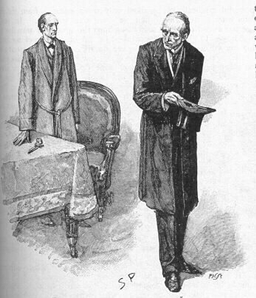 PROFESSOR JAMES MORIARTY is in his forties. He is slim with slightly graying hair. He usually appears disguised as an older, stoop-shouldered, balding man. This is an exact reproduction of his oldest brother, whose identity he assumed. Moriarty’s head oscillates back and forth when he talks and is a most distinctive habit. It was thought that he died in 1888, falling off a ledge with Sherlock Holmes.
PROFESSOR JAMES MORIARTY is in his forties. He is slim with slightly graying hair. He usually appears disguised as an older, stoop-shouldered, balding man. This is an exact reproduction of his oldest brother, whose identity he assumed. Moriarty’s head oscillates back and forth when he talks and is a most distinctive habit. It was thought that he died in 1888, falling off a ledge with Sherlock Holmes.
However, neither man went over the edge and both have returned to London in 1891. Moriarty rarely loses control of his emotions but effectively conveys a sense of menace with his quiet tone. He rules his crime family with an iron hand and all fear him. He aspires to be the greatest criminal in the world, and to also kill Sherlock Holmes.
PIP PAGET, in his early thirties, is one of Moriarty’s inner-circle. He is a large, strong man, raised on the streets of London’s East End. However, he is intelligent and Moriarty has taught him some refinement. Paget is loyal to the Professor. He is also in love with FANNY JONES, who lives with him at the Professor’s headquarters. Paget wants to continue serving the Professor, but he also wishes to start a new life with Fanny and wonders if he can do it, surrounded by the Family.
FANNY JONES, a pretty woman with red hair, is in her late twenties and is Pip Paget’s lover. She had been working as a housemaid in a London mansion. She refused to give in to the butler’s advances so he had her dismissed, without reference. She is devoted to Paget and dreams of someday living with him in a country cottage, far away from the grime and crime of London.
ALBERT SPEER, in his late thirties, is another of Moriarty’s inner-circle. He is an ex-boxer with a flat nose and a large scar running down his face. Speer is extremely strong and lives to serve Moriarty. He is completely loyal and would do anything for him.
EMBER is a small, weasel-like man also in the inner-circle. It’s hard to tell his age, but likely in the late thirties. He is often dirty from moving about the streets, overseeing his responsibilities. Most people dislike him.
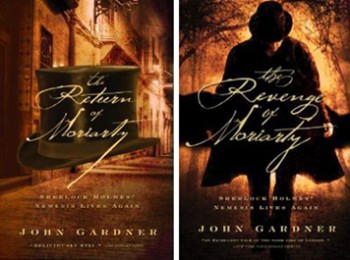 LEE CHOW is the final member of the inner-circle. He is a small, well-dressed Chinese man in his early thirties. He speaks fluent English, with the occasional mistake. He often smiles and always carries a deadly looking knife. Lee Chow enjoys hurting Moriarty’s enemies and is often chosen when the Professor wants to teach a lesson.
LEE CHOW is the final member of the inner-circle. He is a small, well-dressed Chinese man in his early thirties. He speaks fluent English, with the occasional mistake. He often smiles and always carries a deadly looking knife. Lee Chow enjoys hurting Moriarty’s enemies and is often chosen when the Professor wants to teach a lesson.
ANGUS CROW is a Scotland Yard inspector in his late forties who was recently married. Crow is a no-nonsense Scotsman with a solid build and a logical mind.
SHERLOCK HOLMES is the greatest detective in the world. Tall and thin, he is Moriarty’s archenemy. He strives to rid London of the man. Holmes is brilliant, arrogant, determined and athletic.
Pip Paget serves Professor James Moriarty, Sherlock Holmes’ archenemy. It was commonly believed that Moriarty was killed in mortal combat with Holmes in 1888, plunging to his death at the Reichenbach Falls. But just as Holmes survived that encounter, so did Moriarty. The Professor returns to London in 1891 to once again assume his place as the Gaslight Godfather; ruler of the Victorian underworld. Paget loves Fanny Jones and wonders how he can faithfully serve the Professor while building a new, safe life with her. It is a dilemma that grows more difficult as the series progresses.
Moriarty’s chief of staff, Colonel Sebastian Moran, does not relish playing second fiddle again and has his own ideas. Two upstarts have formed their own mob, desiring to take over the Professor’s rackets. Moriarty must crush them, deal with Moran and re-assert his dominance. He is unaware that there is a traitor within his inner circle.
He is also devising a plan to form an alliance with four of Europe’s criminal masterminds, which will be punctuated with a daring attempt to assassinate the Prince of Wales, heir to the throne of England. Throughout, Sherlock Holmes and Inspector Angus Crow of Scotland Yard pursue the Professor.
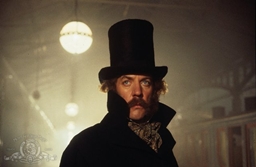 Moriarty’s role in other crimes is explored throughout the series. We learn of how he killed his eldest brother, a mathematical genius, and assumed his identity. There is the famous Jack the Ripper case. We see how he engineered a scandal that rocked Scotland Yard, and his involvement with the adventures Dr. Watson recounted in stories such as The Valley of Fear. And along the way, we find out what really happened at the Falls on that ledge with Sherlock Holmes.
Moriarty’s role in other crimes is explored throughout the series. We learn of how he killed his eldest brother, a mathematical genius, and assumed his identity. There is the famous Jack the Ripper case. We see how he engineered a scandal that rocked Scotland Yard, and his involvement with the adventures Dr. Watson recounted in stories such as The Valley of Fear. And along the way, we find out what really happened at the Falls on that ledge with Sherlock Holmes.
It’s Elementary – Otto Preminger was prepared to make a big screen adaptation of The Return of Moriarty, starring Donald Sutherland. However, funding fell through and the project was scrapped.
PILOT
Ronald Adair accuses his card partner, Colonel Sebastian Moran, of cheating. If Moran does not resign from his clubs within one week, Adair will expose him. Moran agrees and leaves. Moran returns at night and shoots Adair from across the street. Since Adair’s body is found in a locked room, Inspector Lestrade and Doctor Watson are puzzled.
Out on the street, Watson bumps into an elderly bookseller who drops his books and berates him. The man appears at Watson’s home to apologize. When Watson turns away he disposes of his disguise and reveals himself as Sherlock Holmes, thought dead the past three years.
Professor James Moriarty, also thought dead for the three previous years, is back in his London headquarters, meeting with his chief lieutenants. He admonishes Moran for killing Adair, which draws unwanted attention from Holmes. He orders Moran to leave Holmes alone; Moran grumpily agrees. Moriarty starts planning for a meeting of Europe’s criminal masterminds.
People under Moriarty’s protection, members of his criminal family, seek favors from him. He promises to free Hetty Jacobs’ two sons from prison. They are criminals who work for him.
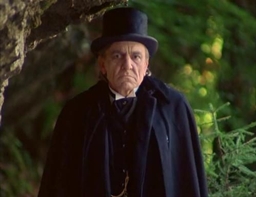
Moran defies Moriarty and goes to kill Holmes with the same air gun he used on Adair. But he springs a trap laid by Holmes and is captured in the attempt. He is arrested for the Adair murder. Moriarty is furious. He’s also angered that Moran was letting matters slide while Moriarty was gone and not reporting everything to him. Moriarty finds out that Pip Paget, one of his inner circle, has a woman living with him at the headquarters. Moriarty decides that Moran will tell all he knows to save his own neck and must be disposed of.
Michael the Peg (Michael Green) and Lord Peter the Butler are two upstarts who had been moving in on Moriarty’s operations. He vows to destroy them and begins making plans. He also meets Paget’s woman, Fanny Jones, after sending him to the countryside to check up on a possible manor burglary. Moriarty verifies the story of Fanny’s dismissal from service and decides to use her for an errand. She delivers a basket of poisoned food and wine to Moran in his jail cell. He dies a painful death, alone in his cell.
The events in the following two paragraphs were incorporated into the revised two-hour pilot:
Moriarty settles a dispute between two women and orders the daughter of one to come to his chambers at night. Another man had tossed acid into the face of a girl whose parents are under his protection. Lee Chow, one of his inner circle, disfigures the man’s face in revenge.
Paget scopes out the country house burglary, then tells Fanny she delivered poisoned food to Moran. Moriarty captures two of Green and Butler’s men and they tell all they know. Angus Crow is assigned by Scotland Yard to investigate Moran’s murder. He consults with Sherlock Holmes. Albert Speer, one of Moriarty’s inner circle, is captured by Green and Butler. Moriarty springs the Jacobs brothers from prison, replacing them with Green’s two men.
FUTURE EPISODES
- Blood Brothers – A flashback episode in which we learn that the Professor is one of three brothers named James. The eldest is a brilliant mathematician overly fond of associating with his younger male students. Moriarty is the middle brother and an aspiring but modestly successful criminal. He plays upon his brother’s weakness, kills him and assumes his identity. The “new” Moriarty rapidly climbs the ladder to become a master criminal.
- This Town Isn’t Big Enough (part 1) – Once members of Moriarty’s gang, Michael the Peg and Peter the Butler formed their own criminal organization during Moriarty’s three-year absence. They intend to supplant the remnants of the family and control the London underworld. They kidnap Albert Speer and attempt to assassinate Moriarty.
- This Town Isn’t Big Enough (part 2) – Moriarty survives the attempt to kill him. He gathers his forces together and launches an assault on Peg and Butler’s operations. They escape, but in his fury he completely destroys their upstart organization.
- I Do – Fanny agrees to marry Paget and the Moriarty family gives a gala wedding. Inspector Crow starts to make progress investigating the Professor’s organization. At the wedding, Moriarty is betrayed from within and is nearly killed in his own quarters by Peg and Butler.
- But You Can Call Me Jack – A flashback episode in which a serial killer is terrifying streetwalkers in the Whitechapel area. Jack the Ripper has all of London afraid, but the East End belongs to Moriarty and he puts his family to work, searching out the killer’s identity. We discover that where the police and even Sherlock Holmes failed, Professor Moriarty succeeded.
- Partners in Crime – The leaders of the Paris, Madrid, Rome and Berlin underworlds come to London to hear Moriarty’s proposal for a continental alliance of crime. Holmes is suspicious of this gathering and attempts to get to the bottom of it. Moriarty outmaneuvers him and the visitors are pleased with his vision for a confederation of their powerful organizations. Future criminal undertakings will be developed.
- The Cleveland Street Affair – Possibly a flashback episode, it’s about a Victorian scandal involving powerful men visiting a brothel full of young males. Moriarty was the mastermind of the affair, using it as a blackmailing scheme. Holmes cracks the case, however, inconveniencing Moriarty.
- The Valley of Fear – Dr. Watson wrote about this case, in which Holmes solves a murder at Birlstone Manor. However, Moriarty was behind the affair, and we see the case from his point of view. It wasn’t quite the complete victory for Holmes that Watson made it seem.
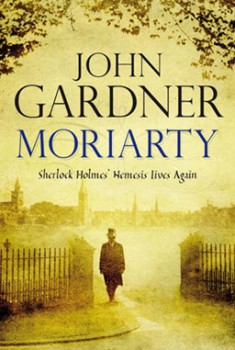 (Moriarty’s role in Holmes’ cases, such as The Hound of the Baskervilles, “The Red Headed League” and other Arthur Conan Doyle originals, will be told in various future episodes, but from an entirely original perspective.)
(Moriarty’s role in Holmes’ cases, such as The Hound of the Baskervilles, “The Red Headed League” and other Arthur Conan Doyle originals, will be told in various future episodes, but from an entirely original perspective.)
- A Day in the Country – Paget helps rob a mansion in the country. He doesn’t realize that two of his companions killed the elderly servants. When he does discover this, he takes Fanny and they flee the Professor’s house.
- Come Out, Come Out, Wherever You Are – Moriarty searches for Paget. At the same time, he begins his attempt to assume the identity of Dr. Night, a stage magician of some note. This is the crux of his plan to assassinate the Prince of Wales. To protect Fanny, Paget approaches Crow and gives him information about Moriarty.
Royal Magic – Moriarty kills, then impersonates, Dr. Night. Using this new persona, he gains access to the royal estate at Sandringham. Performing before the Prince of Wales, heir to the English throne, his assassination attempt is thwarted at the last moment by the arrival of Holmes and Inspector Crow.
With two more books in the trilogy and no shortage of possible stories involving Sherlock Holmes, as well as Victorian London, this series could go for a few years.
You can read Bob Byrne’s ‘The Public Life of Sherlock Holmes’ column here at Black Gate every Monday morning.
He founded www.SolarPons.com, the only website dedicated to the ‘Sherlock Holmes of Praed Street’ and blogs about Holmes and other mystery matters at Almost Holmes.
His “The Adventure of the Parson’s Son” is included in the largest collection of new Sherlock Holmes stories ever published (well, about to be…)
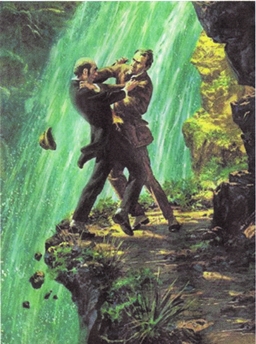
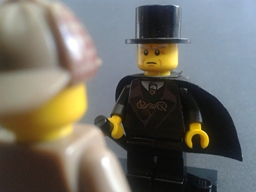
‘Moriarty and the Real Underworld’ was an essay written by Gardner back around the time of the first book. It’s included in Peter Haining’s ‘A Sherlock Holmes Companion.’
I think it’s a fun little piece and you can read it here.
http://webpages.charter.net/sn9/literature/moriarty.html
I will be doing a post about the trilogy itself at some point. I’m a big John Gardner fan. He was the official James Bond author for many years. And ‘The Dancing Dodo’ is a Jack Higgins-esque thriller and one of my favorite adventure books. Gardner was an excellent writer.
Very interesting indeed about the Moriarty plans of old. You had mentioned this to me several times in the past, but I hadn’t heard the whole story. With the continuing upswing of interest in Holmes, and also with the popularity of shows like Ripper Street and Game of Thrones (which I mention only because it shows how much more is tolerated on TV now in terms of graphic violence and dangerous societies), there might be a new interest in this. In fact, this really seems to be a perfect program for television right now. I hope that someone sees this blog and pursues it, and that you are as involved as you want to be.
I’ve read the Gardner Moriarty books several times, and enjoy them very much. I’ve always revised them in my head, in that the youngest James Moriarty (Jamie) did not actually kill his older brother, the true Professor, in order to take his identity. Rather, he first started out wearing the older “Professor” costume in order to help the real Professor, who sometimes needed to appear to be in two places at once. Later, when the Professor was presumed dead at Reichenbach, Jamie returned to London and tried to take the real Professor’s place.
Jamie’s story about killing his brother years earlier was just that – a story – which he spread around in order to take over the Professor’s organization. What he wrote in his journals was simply a falsification of his own coded notes – the very same coded notes that Gardner found and used to produce the later books. (I believe that Gardner comments along the way in a footnote or two indicate that he, too, questioned the veracity of the original journals somewhat.) I think that the oldest brother, the real Professor, wasn’t really killed by the youngest brother, Jamie, years before, and that the Professor didn’t really die as presumed at Reichenbach either – although I do believe he went over the Falls, and that Holmes sincerely believed him to be dead. The (real) Professor just took a long time to recover. (There are too many other stories where the true Professor appears after Reichenbach.) Rather than being dead, the true Professor finally returned to London in the late 90’s to find that his brother, Colonel Moriarty (strangely hardly mentioned as a player in Gardner’s books) and the youngest, Jamie (the main character in Gardner’s books) have tried to restart the original Professor’s organization in his absence, to limited success.
As a hard-core Chronologist, I am curious as to why you had a three-year time shift in your setting, as mentioned in the initial description. You place the current events, with Moriarty’s return to London, in 1891, with Holmes and the Professor’s earlier battle having taken place in 1888. However, in the Canon and Gardner’s first book, the dates are 1894 and 1891, respectively.
I hope that someone notices this and starts production immediately, and that you go along for the ride. It should be a great companion show with Bert Coules’ unproduced Holmes series, which I also wish would happen: http://www.bertcoules.co.uk/221b.php